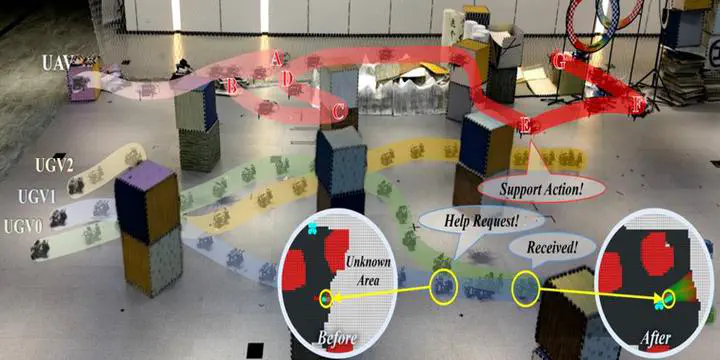ColAG
Collaborative Air-Ground System to Boost Air-Gound Cooperation

Perception is necessary for autonomous navigation in an unknown area crowded with obstacles. It’s challenging for a robot to navigate safely without any sensors that can sense the environment, resulting in a blind robot, and becomes more difficult when comes to a group of robots. However, it could be costly to equip all robots with expensive perception or SLAM systems. In this paper, we propose a novel system named ColAG, to solve the problem of autonomous navigation for a group of blind UGVs by introducing cooperation with one UAV, which is the only robot that has full perception capabilities in the group. The UAV uses SLAM for its odometry and mapping while sharing this information with UGVs via limited relative pose estimation. The UGVs plan their trajectories in the received map and predict possible failures caused by the uncertainty of its wheel odometry and unknown risky areas. The UAV dynamically schedules waypoints to prevent UGVs from collisions, formulated as a Vehicle Routing Problem with Time Windows to optimize the UAV’s trajectories and minimize time when UGVs have to wait to guarantee safety. We validate our system through extensive simulation with up to 7 UGVs and real-world experiments with 3 UGVs.
Following this work, we further propose a system has only one depth camera with a field of view for environmental perception. We fully explore the cooperation between robots by proposing a Sequential Exploration and Aiding Localization (SEAL) planning strategy for the UAV and a Collision-Adaptive Trajectory (CAT) optimization for UGVs. The UAV assists UGVs’ localization with relative pose estimation and own global localiza- tion, meanwhile, it focuses on exploration to provide UGVs with abundantenvironmentalinformation.TheUGVteamcannavigate safely and autonomously in obstacle-rich environments and even maintain formations with only the wheel odometer and UAV’s assistance using CAT optimization. Our method is validated both in simulations and real-world experiments indoors and outdoors.
Related Publications: